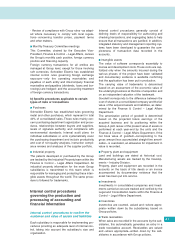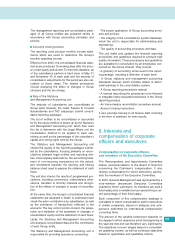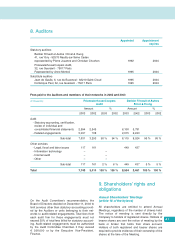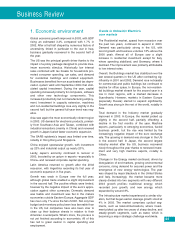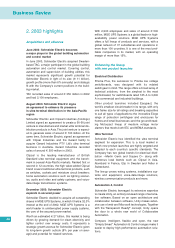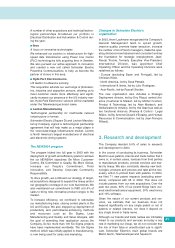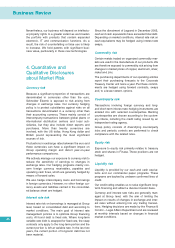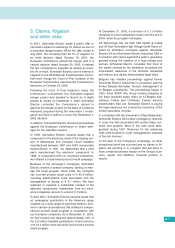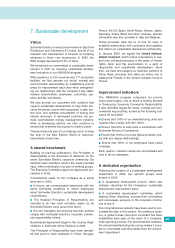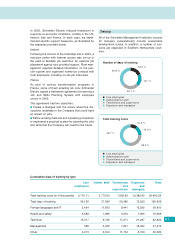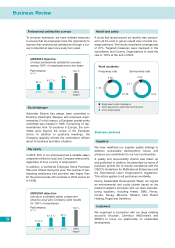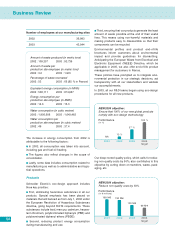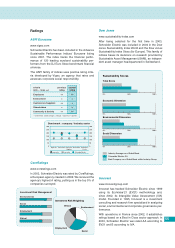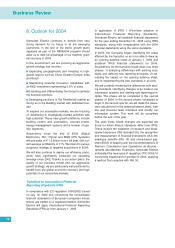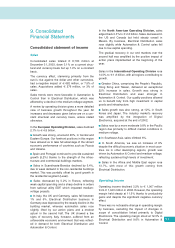APC 2003 Annual Report Download - page 49
Download and view the complete annual report
Please find page 49 of the 2003 APC annual report below. You can navigate through the pages in the report by either clicking on the pages listed below, or by using the keyword search tool below to find specific information within the annual report.
5. Claims, litigation
and other risks
In 2001, Schneider Electric made a public offer to
purchase Legrand in exchange for shares as part of
a proposed merger project. When the offer closed in
July 2001, the Company held 98.1% of Legrand. In
an initial decision dated October 10, 2001, the
European Commission vetoed the merger, and in a
second decision dated January 30, 2002, it ordered
the two companies to separate as quickly as possi-
ble. As a result, Schneider Electric sold its interest in
Legrand to the KKR-Wendel Investissement consor-
tium even though the Court of First Instance of the
European Communities overruled the Commission’s
decisions on October 22, 2002.
Following the Court of First Instance’s ruling, the
Commission re-examined the Schneider-Legrand
merger project and decided to launch an in-depth
(phase 2) review on December 4, 2002. Schneider
Electric contested the Commission’s refusal to
approve the merger project on the basis of corrective
measures proposed during the new phase 1 investi-
gation and filed a petition to annul the December 4,
2002 decision.
In addition, Schneider Electric launched proceedings
against the European Commission to obtain dam-
ages for the prejudice caused.
In 1996, Schneider Electric became aware that a
component in the electronic cards of the tripping sys-
tem of Masterpact and Compact circuit breakers
manufactured between 1987 and 1992 occasionally
malfunctioned. In 1997, we determined that a third
party manufactured the electronic component. In
1998, in cooperation with our insurance companies,
we initiated a broad-based product recall campaign.
Because of the campaign’s complexity, Schneider
Electric created a special company, Spring, to man-
age the recall program. Since 1998, the Company
has incurred product recall costs of € 40.9 million,
including administrative costs associated with the
management of Spring of € 6.7 million. We have
replaced or repaired a substantial number of the
defective components. Indemnities from our insur-
ance companies amount to around € 3 million.
In April 2001, Schneider Electric became aware that
an emergency pushbutton in the Harmony range
installed on a wide range of machines failed to func-
tion in certain circumstances. We initiated a compre-
hensive product recall program in cooperation with
our insurance companies. As of December 31, 2003,
we had located and repaired approximately 16% of
the 2.2 million installed pushbuttons. Total provisions
of € 18.3 million were set aside for the entire product
recall program.
At December 31, 2003, a provision of € 1.3 million
remained to cover replacement costs until the end of
2004, when the program will expire.
VA Technologie AG, VA Tech T&D GmbH & Cokeg
and VA Tech Schneider High Voltage GmbH have ini-
tiated an arbitration procedure against Schneider
Electric SA and Schneider Electric Industries SAS in
connection with claims against the seller’s guarantee
granted during the creation of a high-voltage joint
venture. Schneider Electric considers that most of
the claims covered by the arbitration procedure are
time-barred, excessive in the amounts requested
and without any clearly demonstrated legal basis.
Belgium has initiated proceedings against former
Schneider Electric executives in connection with the
former Empain-Schneider Group’s management of
its Belgian subsidiaries. The proceedings began in
1993, when SPEP (the Group holding company at
the time) launched public offers for its Belgian sub-
sidiaries Cofibel and Cofimines. Certain minority
shareholders filed suit. Schneider Electric is paying
the legal expenses not covered by insurance of the
former executives involved.
In connection with the divestment of Spie Batignolles,
Schneider Electric SA booked contingency reserves
to cover the risks associated with certain major con-
tracts and projects. Most of the risks were extin-
guished during 1997. Reserves for the remaining
risks were booked to cover management’s estimate
of the risk involved.
To the best of the Company’s knowledge, no other
exceptional event has occurred and no claims or liti-
gation are pending or in progress that are likely to
have a material adverse impact on the Group’s busi-
ness, assets and liabilities, financial position or
results.
47


